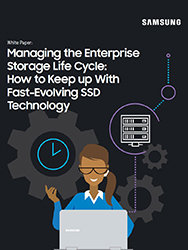All storage media have limited lifetimes, including both hard disk drives (HDDs) and solid state drives (SSDs).
Hard disks are limited by mechanical wear. For example, drift — the difference between where a data track is on the physical disk, and where the controller thinks it is — can change over time, resulting in data on the track getting harder to read.
SSDs, on the other hand, tend to withstand much heavier use for far longer than their HDD ancestors, because there are no mechanical parts to wear out. Still, the NAND cells that store data in SSDs will permit a limited number of times that data can be written to each cell.
It’s therefore important for enterprises to perform regular HDD and SSD health assessments to maintain uptime and prevent data loss. With hundreds or thousands of sometimes varying storage devices in a data center, however, this is no simple task — at least, not without the right tools.
Calculating SSD Lifespan
Predicting the lifespan of an SSD is a complex calculation, and will vary drastically for different workloads. Some operations — such as write once, read many (WORM) — can result in effectively perpetual lifetimes, since only writes wear the drive out, while reads have little or no effect on the drives’ mortality.
At the other end of the spectrum, write-heavy workloads with tons of small, random writes can wear a drive out rapidly. One of the reasons for this is that each byte of data written to an SSD actually causes the whole block containing that bit to be rewritten — a multi-step process requiring the block to be read, then erased, then rewritten with the new information. Since SSD blocks typically consist of 128 or 256 pages — each page holding 2KB, 4KB, 8KB or 16KB — a block can vary in size from 256KB to 4MB. To write one byte, therefore, a drive must erase as many as four million bytes, then write the same 4MB to the SSD. This process is known as write amplification — in other words, the much larger amount of data that has to be written in order to write a small amount of data.
Manage the Enterprise Storage Life Cycle
Download this guide to improve your storage planning and evaluation processes. Download Now
If data is written sequentially, the system can collect a number of writes and write them all to disk at once, consolidating all of the data intended for one block and writing it at once. With random writes, on the other hand, this becomes much harder to do, and keeping the data for extended periods of time can cause problems if the system loses power, since the writes being held can be lost before they’re written.
Predicting the service life of an SSD thus involves a number of factors. The actual load created by the application that will use the storage needs to be run on the drive over at least 12 hours, if not several days, and then the collected data must be analyzed to find out the ratio of reads to writes; the total amount of data written; whether it’s mostly random or sequential; and the write amplification factor — that is, the typical increase in the data written based on the size of the data versus the size of the blocks on the SSD.
Monitoring Storage the SMART Way
Collecting and analyzing all of this data can be done much more effectively through the use of SMART attributes. Self-Monitoring, Analysis and Reporting Technology (SMART) is built into both hard disks and SSDs, and enables the drives to send data to their connected systems, reporting on a variety of attributes that indicate drive health and reliability.
Samsung enterprise SSDs such as the Samsung 860DCT and the SM863a come with a SMART monitoring toolkit called Samsung Magician Software for Enterprise SSDs, which not only collects the necessary data, but can also simplify the calculations by collecting extra data not available from other SMART enabled disks, such as Wear Leveling Count, Timed Workload Media Wear, Timed Workload Host Read/Write Ratio and Timed Workload Timer. These attributes work with the Magician software and an analyzer function to predict drive lifespan based on a load recorded over a particular time, without needing to manually calculate the formulas.
For administrators trying to estimate how long SSDs will last for a given application, the Samsung Magician Software in combination with Samsung enterprise SSDs will greatly simplify the process of characterizing loads, granting a much more accurate prediction of how long the SSDs will last in your particular application.
Find the best storage solutions for your business by checking out our award-winning selection of SSDs for the enterprise.








